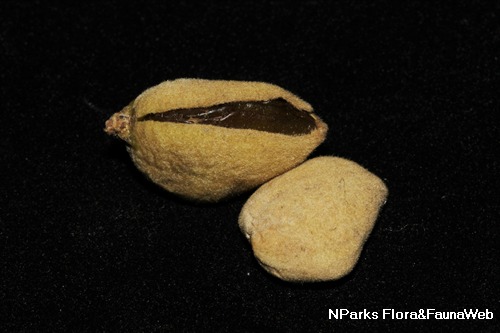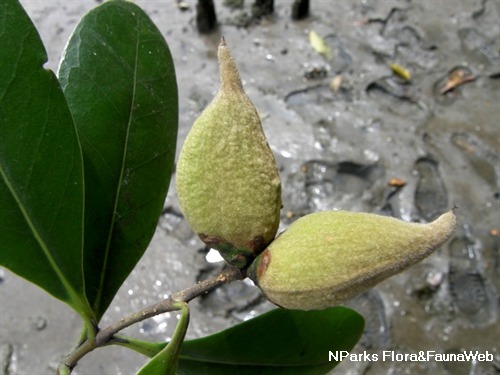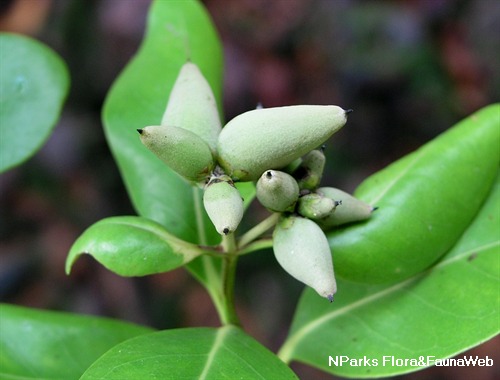
Back
Avicennia rumphiana Hallier f.
| Family Name: | Acanthaceae |
| Synonyms: | Avicennia lanata |
| Common Name: | Api-api Bulu |
Name
Classifications and Characteristics
| Plant Division | Angiosperms (Flowering Seed Plants) |
|---|---|
| Plant Growth Form | Tree (Medium (16m-30m), Small (6m-15m)) |
| Lifespan (in Singapore) | Perennial |
| Mode of Nutrition | Autotrophic |
Biogeography
| Native Distribution | Southeast Asia, including Singapore, and Papua New Guinea |
|---|---|
| Native Habitat | Shoreline |
| Preferred Climate Zone | Tropical, Sub-Tropical / Monsoonal |
| Local Conservation Status | Native to Singapore (Least Concern (LC)) |
Description and Ethnobotany
| Growth Form | Medium-sized to big tree, reaching up to 30 m tall. |
|---|---|
| Trunk | Dark grey and smooth bark, not buttressed but cylindrical, straight trunk when growing in a closed stand. |
| Roots | Pencil-like pneumatophores emerge above ground from long shallow underground roots. |
| Foliage | Ovate or elliptic leaves, simple, opposite, measuring up to 10 by 6 cm, thick, margin entire with non-curved edges, dark green above, beneath covered with dense, powdery hairs. Midrib of leaf is prominent beneath, covered with hairs, leaf stalk about 18 - 20 mm long. |
| Flowers | Orange-yellow flowers are fragrant and clustered in three-branched heads, all parts densely covered with very fine hairs. Corolla smooth inside, hairy outside, lobes recurved. |
| Fruit | Fruit is broadly ovoid, compressed, not more than about 18 mm long and covered with dense woolly hairs. All Avicennia spp. exhibits crytovivipary, in which the embryo germinates within the fruit but does not enlarge enough to break through the fruit wall. |
| Habitat | Usually occurring in the downstream estuarine zone in the high intertidal region. |
| Etymology | Avicennia is named in honour of the Persian physician, Avicenna (980 - 1037). |
| Ethnobotanical Uses | Edible Plant Parts : Edible Fruits Timber & Products: Wood used as firewood to smoke fish or rubber. |
Landscaping Features
| Desirable Plant Features | Fragrant |
|---|---|
| Landscape Uses | Coastal, Riverine |
Fauna, Pollination and Dispersal
| Pollination Method(s) | Biotic (Fauna) |
|---|---|
| Seed or Spore Dispersal | Abiotic (Water) |
Plant Care and Propagation
| Light Preference | Full Sun, Semi-Shade |
|---|---|
| Water Preference | Lots of Water |
| Plant Growth Rate | Moderate |
| Rootzone Tolerance | Waterlogged Soils |
| Potential Problems | Sooty mold |
| Propagation Method | Viviparious Propagule |
Foliar
| Foliage Retention | Evergreen |
|---|---|
| Foliar Type | Simple / Unifoliate |
| Foliar Arrangement Along Stem | Opposite |
| Foliar Attachment to Stem | Petiolate |
| Foliar Venation | Pinnate / Net |
| Foliar Margin | Entire |
Non - Foliar and Storage
| Mature Bark Texture | Smooth |
|---|
Floral (Angiosperm)
| Flower Colour(s) | Orange, Yellow / Golden |
|---|---|
| Flower Grouping | Cluster / Inflorescence |
Image Repository
Others
| Master ID | 29280 |
|---|---|
| Species ID | 3589 |
| Flora Disclaimer | The information in this website has been compiled from reliable sources, such as reference works on medicinal plants. It is not a substitute for medical advice or treatment and NParks does not purport to provide any medical advice. Readers should always consult his/her physician before using or consuming a plant for medicinal purposes. |


.jpg)
-(13).jpg)
-(10).jpg)




